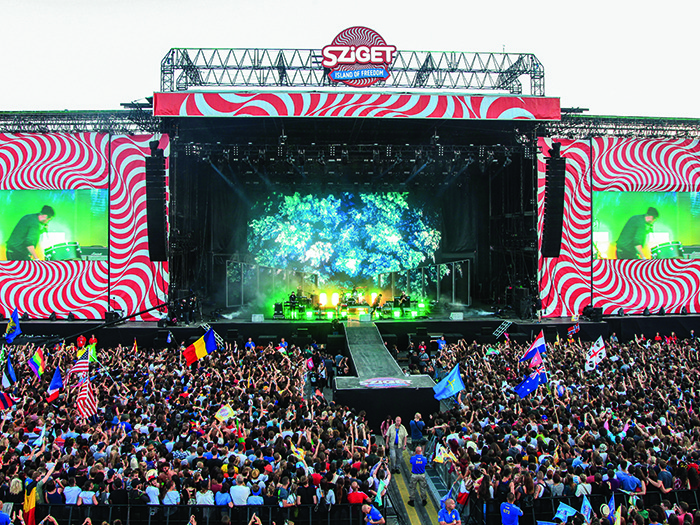Sziget offers its guests a beautiful setting for its world class production values, and boasts an international crew who put hospitality second only to event safety and quality. Kelly Murray took a trip to the iconic Island Of Freedom to look at what its main stage had to offer…
Hungary’s Sziget Festival is a not-so-hidden-gem of the festival world. Set on a tiny island, linked to the city of Budapest by bridge, Sziget now attracts 450,000 music fans from almost 100 countries to experience the week-long outdoor event. 2016 played host to some very sought-after performers from all manner of genres. The eclectic line up that played between 10-17 August included Bring Me The Horizon, John Newman, Sigur Rós, Muse, Rihanna, Manu Chao, Bastille, Sia and Hardwell. It’s easy to see why 25% of tickets sold out in the first 24 hours…
The popularity of the event has been cemented in European festival culture, but this year the crew were also in a state of shock and mourning with the sudden loss of Dan Panaitescu, the festival’s popular International Booking Manager, who was tragically killed in a traffic collision just three weeks before Sziget 2016. An official statement from the festival read: “We are speechless. We have always envied him for not getting older, but we have never ever thought that he would not get old… The whole festival industry is grieving.”
THE SHOW MUST GO ON
With this sadness potentially casting a dark shadow over the festival and its team, Sziget could have easily hit a rough patch. And yet when arriving on site in the blistering heat, the welcoming faces and the camp morale were instantly noticeable. Naturally, road crew have an inherent ‘the show must go on’ mentality, and this case was no exception. In the backstage area of the main stage, a candlelit shrine was placed near Panaitescu’s office, at which all of the people he worked with over the years could pay their respects.
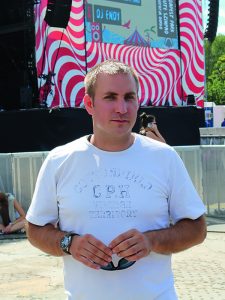
Taking up the role of Head of Production is Daniel Benis, who looks after five festivals throughout the season in Hungary, including Balaton Sound, Volt, Children Island, and Gourmet as well as his biggest production, Sziget. Benis has taken on a weighty task despite his relatively young age. His story is an interesting one; he was, at the start of his career, a history teacher. He explained: “My diploma is in economics and management, so when I decided to join this industry, I had to learn everything on the job.”
“What’s remarkable is the fact that I became the Head of Production aged 25.” He continued: “I’m now 34 years old, and I’ve learnt so much over the years. The biggest challenge was wanting to change how things were done within the production. I was the new guy fighting with old standards. I’m very interested in health and safety issues and crowd control, and we’ve progressed with that greatly in recent years. Now we’re working with Mojo Barriers I’m educating the security teams on how to use their systems. We need these barriers in place for our pits because they are the best, and we’re serious about what we do on this site.
“It’s the same with the constant updates in technology, as I’m very curious about new products. I’ve learned about the MA Lighting grandMA2 desk, and how to operate the Robe BMFLs. We’re also using a Martin Audio MLA system for the second time, and we’re very happy with the results once again. As always, it’s been tiring but we’re happy with what we’ve done so far. The good thing about our production is that we’re always looking for ways to improve. Next year we know already that we’re going to make this stage bigger.”
“Outside of the technical aspects, we’ve also invested a lot in making the festival a great place to visit in terms of what it looks like. People are coming to Sziget on holiday so they have to want to stay on site for a week.”

Benis’ right hand man is Stage Manager and acting main stage Production Manager Zsolt Szicso – fondly referred to as ‘George’, much to the relief of TPi’s questionable accent. He himself has a long history with the festival, begining his time with Sziget in 1993 as a lighting tech. In 2002 he left to concentrate on political and corporate event production before being asked back by Panaitescu four years ago to take up his current role. He told TPi: ”It’s not as simple as saying ‘this is my job and that’s the only work I undertake’. We all help each other with various duties. I work on the technical production, with booking agents, in hospitality; we’re always working as a team. It’s the Hungarian way to do more than one aspect of a job and pitch in all together.”
Over the last few years Szicso has seen the changes implemented on the main stage such as the introduction of the Martin Audio MLA system from Capital Sound, lighting rig changes, and the addition of the Stageco roof. He continued: “The key thing for having a successful stage is having a great team to work with – I need people around me that I can trust. It’s very important to look after every band that plays on your stage too, it’s not just about the main headliners. We want to understand why someone is happy or stressed so that you know what’s working or if a problem needs fixing. At Sziget we want people to feel at home. Obviously how the stage is delivered affects the arts and their crew, but it also affects the crowd’s experience.”
Szicso was also keen to heap praise on his Finnish Co-Stage Manager, Peppi Lotta Arrimo: “We’ve worked together for two years now at the festival. She’s become an essential member of the Sziget main stage family.”
THE AUDIO SOLUTION

Following an introduction to the festival organisers at Germany’s Prolight+Sound tradeshow, Capital Sound first supplied equipment to Sziget in 2006 with its Meyer Sound PA inventory and some DiGiCo D5 consoles for FOH and monitor duties. Over the next decade, the relationship between the British rental company and Hungary’s premier music festival became cemented, with Capital’s Paul Timmins looking after the account. It was determined that, as the festival was growing in size, so should its main stage audio design. Timmins recalled how he’s seen the festival develop into the heavyweight attraction it is today. “By 2009 we were sending a complete A+B flip flop monitor system for the main stage with local Hungarian vendor, Expander 2000. 2010 was the first year we supplied – with the exception of the delay towers – the complete main stage system. At this point we were still only sending one audio tech over from the UK and the local Hungarian crew worked with the system. Over the next couple of years we continued to upsize and upgrade the design. In 2011 we were very close to providing a festival package that would be considered UK standard. By 2013 we’d made a key investment with Martin Audio’s MLA system due to the demands we were seeing for that particular system at venues such as London’s Hyde Park for the British Summer Time events.
“In order to continue our relationship with Sziget, we sourced the new Meyer Sound LEO system from a Meyer Sound rental partner in Poland as per the festival’s request. Then in 2014, as our track record at delivering quality audio had been established, we were asked to look at supplying audio for Sziget’s sister festivals Volt and Balaton Sound.”
An important aspect of Capital’s DNA is its knowledge and expertise when it comes to different sound systems. It currently offers four different audio brands to its clients – Martin Audio, Meyer Sound, d&b audiotechnik and Outline – with a ‘one size does not fit all’ motto.
As Capital was going through its own inventory changes, Timmins suggested that the festival should consider using the MLA system for all three events. He continued: “We were now dealing directly with the festival and it was decided that Capital would supply both Volt and Balaton Festivals in order to try the MLA system, but Sziget’s main stage was again awarded to their local supplier. The MLA proved itself however, and in 2015 MLA was also specified for Sziget.”
The supply included four main MLA field delays and a central mix tower of MLAC delays. “Due to the incredible success of how the MLA performed in 2015 we managed to get through a lengthy tender process and have now secured a contract with MLA for the next couple of years, which also includes supplying the two sister festivals,” said Timmins. “I’m really happy about it because we love being involved with these festivals. The teams in Hungary are great to work with because they genuinely care about their events. They’re very passionate about what they do, and that makes it all the more worthwhile when you’re sending trucks of equipment over. We also get to meet a lot of touring crews coming through and using the MLA system. It’s been a really popular move to make.
“The 2016 MLA design rocked, even with the increased audience size this year, the optimisation tweaks gave incredible coverage and high SPL across the whole audience area. The Introduction of the Spaced MLX sub array gave impact and control with headroom for even the loudest acts. Sound system choice may be subjective, but all of the visiting engineers this year were complimentary about the design and PA performance. Muse’s crew in particular went out of their way to express their delight with the system.”
To complete the audio package, Capital also supplied two Avid Profile desks for FOH and two Yamaha PM5Ds for monitors. The latter was specified for the last time, as Timmins noted: “The PM5D is a very standard desk to use at monitors – it’s been seen on festivals everywhere for the last 10 years – but we’ve made the decision that it will be the last time we supply it; we’re moving into a new era and replacing those desks with the Yamaha CL5 console.”
For RF, six ways of handheld Shure UHFR radio microphones were chosen, and Shure was also the brand of choice for in-ears, resulting in the specification of 10 PSM1000’s. Although most artists brought in their own microphones, a mixed package of Sennheiser, Shure, Audio-Technica, Harman’s AKG and Audix was supplied.
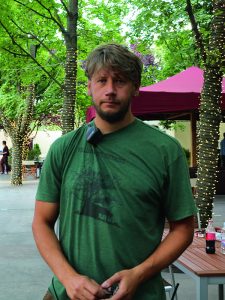
Handling the sound teams on site is the Hungarian Audio Crew Chief, Marci Mezei, himself a Sziget veteran. He told TPi: “I spend a lot of my year on tour, but when I’m travelling, I work on Sziget. I must like this festival because I keep returning – it’s my 15th year here and my 13th working on the main stage. The festival just keeps getting stronger.”
LIGHTING AND VIDEO
Mark Kontra, Head of Lighting at the main stage, as well as the area’s lighting and rigging designer stopped by the backstage area for a chat. Now in his sixth year working with Sziget – and his third year in charge – he commented how his company, Colossal, had seen first hand the “complicated” set up the lighting world has to provide for such a wide variety of acts. “I split my crew into two parts – one that works with the headliner act during the overnight load-in and the other that is here for the daytime to look after everyone else. My problem is that I try to be in both of the teams!” Kontra also advances the rigging plots for the Stageco roof team.
“Big bands such as Muse have touring festival designs, so they require a flown rig from us. Muse [operated by double TPi Award-winner Oli Metcalfe] have a very cool, high tech yet festival-friendly design. Bastille have a very awesome visual design too, but my personal favourite is working with The Chemical Brothers – they have lots of equipment and that’s really fun!”
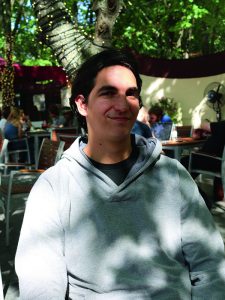
For the main stage fixtures Colossal supplied 32 Vari-Lite VL3500 Washes, 32 Robe BMFL Spots, 40 Robe Pointes, 32 Robe Robin LEDWash 600’s, 24 Robe ColorStrobes, 60 CitySkape 48’s and a mixture of two, four and eight-lite generic molefays.
Kontra furthered: “There’s usually a lot of dust and very little time for maintenance when we’re on site, so we need reliable fixtures. This festival hosts a lot of rock bands, so for our rig we chose to use Vari-Lite VL3500’s a lot in our rig. This light has a big output, creates beautiful colours and has more power than some other options. It’s a key wash light which we see on basically every festival rider. We use a lot of Robe’s new BMFL Spots. These products have a great output and are a very reliable unit, just like the Robe Pointes. We also opted for the new Robe ColorStrobes. The LDs we’ve spoken to have really enjoyed using it.
“For control we have an MA Lighting grandMA2 Full Size and Light for backup. This year I also brought in a High End Systems Hog4 for a few bands that had requested it.
“This job is hard work, but I guess like everyone in this business, you must like the rush of making it happen – we like the excitement when the PA kicks in and the spotlights come on. We’re gadget freaks!” he laughed.
Local Hungarian supplier, Visual Power, also enjoyed its 15th year at the festival, again providing the main stage video requirements. Led by Project Manager Peter Perjesi, the video design delivered a classic look comprising L-R IMAG and an upstage video wall.
The IMAG screens consisted of 9m x 5m of YUCHIP P6.25 per side, while the upstage screen was a 16m x 9m wall of Uniview CO-7.8. The company also provided 200m of 16mm pitch LEDBlade that was installed on the edges of the main stage.
Perjesi explained: “We have been using 8-10mm LED screens over the past few years, but this year we upgraded to 6-7mm in order to have best possible resolution. This is also the second time we have used the LEDBlade system, which has been welcomed again by the bands and performers. We have plans to increase the amount we provide to around 500m next year.”
The vendor also supplied a crew made up of of two project managers, two show operators, a show designer, and three technicians who were on site at all times during the festival.
Perjesi continued: “The look of a festival is much more important these days, I believe. Therefore we try to improve year-on-year, and keep up with the expectations of the present trends and line-ups. We have done this by introducing new systems like LEDBlade, going higher with the resolution, and offering a whole system control for all the available screens. I’m sure that the whole look of a stage like Sziget’s Main Stage will have a considerable effect on the audience, and will definitely enhance the performance of the artists on stage.”
STAGING AND BARRIER SAFETY

Mojo’s Stanley Jilesen, Sziget Account Manager is in charge of the compnay’s international festival and touring clientele. When Jilesen met Benis at an event, it was clear the two had a very similar way of thinking. Jilesen’s approach to crowd control with barrier technology impressed Benis so much in fact, that Mojo won a contract with Sziget almost immediately. This was the beginning of a real breakthrough for the H&S conscious Benis.
Jilesen explained what changes have been made since the two minds met. “When we got involved with this festival, the first thing we altered was the fact that they had no breaker at the main stage area. Once we created one, it kept the pressure off the people at the front of the crowds.
“To be honest, that’s what we do everywhere we work. Every leading festival has something like that factored into its design. People at festivals have a sheep mentality – they will walk until they hit a barrier, and then they stop. If there’s no breaker, they’ll keep on walking and the pressure mounts. Our systems stop this from happening because safer is always better.
“This festival is still evolving because it’s in a somewhat difficult area; we’re placed by the main ‘high street’ within the festival grounds where everybody walks in and around the main stage. Three days ago, Daniel [Benis] called me to say he needed some extra line-up gates; half an hour later we put the extra equipment in a truck to Budapest from Holland. That’s what we’re known for. If our client has a problem, we help them immediately. We always leave a project manager on site in case any changes are required, or if a band wishes to bring in some extra set that affects the barrier layout, such as a catwalk, and having one of our team on site means this can be quickly accommodated. It’s great to work on such a progressive festival, one which has such a brilliant team and which is constantly evolving, and we look forward to building on our relationship in the future.”
Rik Beulin, Mojo’s man on the ground at Sziget, agreed. He commented: “You’ve got to be able to handle your crew and prioritise safety. For example yesterday I put in an extra door into a barrier section. It only took me 10 minutes but we wanted to have an extra door at FOH, and today access works better for everyone who needs to get there.”
A total of 400m of barrier, 50m of High Fence and 20 line-up gates were used for the 2016 event. As well as stage barrier within the main stage arena and line-up gates throughout the festival site, Mojo also supplied its high fence to the main stage FOH in order to enhance security and improve the aesthetics of the structure. With a crew of 10-12 people, Beulink’s team installed these elements in a day.
Jilsen likes being part of the festival’s evolution process. He continued: “We are quite a new suppliers compared to some of the companies they’ve worked with over the years. For us, it feels as though the possibilities are all ahead of us. Sziget is becoming more professional in every aspect now, and as partners it feels very cool to work with a festival that is clearly growing into something bigger and better every year. Also,” he smiled, “a great part of working with Sziget is how nice the people are.”
Benis commented: “Over the last few years, we have used barriers from our existing partners but couldn’t beat the quality of Mojo Barriers, neither in equipment or service. In the last few years nearly all riders have placed greater emphasis upon crowd controlling issues and Mojo Barriers are now seen as a standard, so we had to step up. Mojo’s services and equipment has solved all our problems, and any incoming production manager knows what they are getting when they see Mojo Barriers. Regarding the Hungarian regulations and crowd controlling issues, we had to find a solution to help improve the circulation of the crowds, in terms of normal flow and also in case of heavy crowds. Our security teams were also really satisfied with this.”
Stageco Germany was hired to build a four-tower roof, introducing some key modifications to its standard specifications, such as extending the PA wings to the rear. The goal was to create a structure that allowed the Sziget team to cover the reverse side of the roof with custom made PVC prints. Another ‘special’ for this roof was the inclusion of pyro platforms above the canopy. Hardwell in particular used a vast array of effects from Quantum Special Effects, including its own custom wireless Spitfire Flame System, its show-stopping fireball named ‘The Harvey’, and a burst of summery white confetti and streamers that flew over the happy crowd below.
In total, Stageco Germany delivered around 830 tonnes of gear that, as well as the roof, included the FOH riser, delay towers and 4,500sqm of VIP platform decking. Hungary’s B.L. Crew co-operated on the project, while Manuel Billian led Stageco’s R&D effort and Stefan Stadelmann headed Stageco’s crew.
QUALITY CATERING
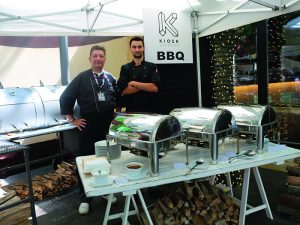
Kiosk is the catering company behind the vast array of culinary compliments we hear flying around over the weekend. Needless to say the risotto station wasn’t going to try itself… credit where credit’s due, the food is freshly made to order with any vegan / vegetarian / cave man preference you have. There are also salad bars, cheese counters, BBQ pits and beautifully-decorated desserts that wouldn’t look out of place in a Disney cartoon.
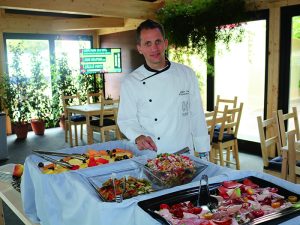
All under the instruction of Head Chef Mihalik Zoltán, the festival is responsible for feeding up to 500 production crew and artists per day. With an impressive 100 catering staff on site, no dietary request is too much for Kiosk. Zoltán is clearly here for his menu moulding and gastronomic creation skills. Having worked at the Four Seasons in central Budapest, his kitchen training is Michelin Star quality.
THE 25TH CELEBRATIONS
2017 will mark the 25th anniversary of Sziget Festival, taking place on 9-17 August. We’ve been left in no doubt that this milestone will involve some extra special celebrations. It certainly delivered a wealth of local and international production knowledge that has worked tirelessly to produce a space that welcomes each and every person with respect and outstanding hospitality.
The festival encourages you to come for a holiday and leave your worries behind as you enjoy a first class festival experience and from what we’ve seen, whether you’re a part of the crew or a member of the audience, the Island of Freedom has set its Hungarian heart on giving you an experience to remember.
TPi
Photos: TPi, Plaster Creative Communications
http://sziget.hu/fesztiva
www.capital-sound.co.uk
www.kiosk-budapest.com
www.colossal.hu
www.visualpower.hu
www.stageco.com
www.mojobarriers.com
www.q-sfx.com
WHAT THE CREW SAY…
JOEL STANLEY
PRODUCTION MANAGER, BASTILLE
 “It’s my sixth year here and I always have a good experience. They’re like our Hungarian family! They definitely go above and beyond to make the experience better. Everyone’s so friendly and the crew are really helpful. We’re not headlining here but they gave us an overnight load-in so that we got some programming time. And whether you’re an artist or part of the production crew, the catering’s amazing – they look after you from the dressing room to your rider, and absolutely nothing is a problem. As I arrived I saw Rihanna’s crew loading out. I used to work for her too, and the guys said to me ‘this festival will look after you’. That makes a huge difference when you’re on show number 174 in the cycle!”
“It’s my sixth year here and I always have a good experience. They’re like our Hungarian family! They definitely go above and beyond to make the experience better. Everyone’s so friendly and the crew are really helpful. We’re not headlining here but they gave us an overnight load-in so that we got some programming time. And whether you’re an artist or part of the production crew, the catering’s amazing – they look after you from the dressing room to your rider, and absolutely nothing is a problem. As I arrived I saw Rihanna’s crew loading out. I used to work for her too, and the guys said to me ‘this festival will look after you’. That makes a huge difference when you’re on show number 174 in the cycle!”
STEVE PRICE
VIDEO DIRECTOR, BASTILLE
 “After doing the rounds of European festivals for a few years you start to bump into people you know over and over again, and some of those people you really look forward to seeing. Zsolt Szicso, our main stage production manager is one of those faces. He’s very video friendly, and so easy going. He even gave me a preshow banana! If you search #preshowbanana on Instagram you’ll see what I’m talking about… [Thanks for the tip Steve, we now stalk you…] I have a banana before every show and a I started Instagraming them a couple of years ago. It took off in a weird way. For example Adam Lambert’s fans often turn up at Queen gigs with bananas for me, so it’s become a bit of a ritual! Bananas aside, Sziget was one of those festivals were everything just lined up in the right way. Bastille are a great band to work with and their crew are awesome. The festival video team were fantastic at Sziget too, and the artist village was one of the best I’ve ever seen. With the sun out and the crowds fired up, it was a perfect day at work.”
“After doing the rounds of European festivals for a few years you start to bump into people you know over and over again, and some of those people you really look forward to seeing. Zsolt Szicso, our main stage production manager is one of those faces. He’s very video friendly, and so easy going. He even gave me a preshow banana! If you search #preshowbanana on Instagram you’ll see what I’m talking about… [Thanks for the tip Steve, we now stalk you…] I have a banana before every show and a I started Instagraming them a couple of years ago. It took off in a weird way. For example Adam Lambert’s fans often turn up at Queen gigs with bananas for me, so it’s become a bit of a ritual! Bananas aside, Sziget was one of those festivals were everything just lined up in the right way. Bastille are a great band to work with and their crew are awesome. The festival video team were fantastic at Sziget too, and the artist village was one of the best I’ve ever seen. With the sun out and the crowds fired up, it was a perfect day at work.”
ROB HIGHCROFT
PRODUCTION MANAGER, BRING ME THE HORIZON
 “Sziget is a great festival to work on; it’s really well-run and expertly organised. Their attention to detail is something more festivals should look towards. 2016 was was under a dark cloud with the departure of much-loved Daniel Panaitescu, who passed away only a matter of weeks before the festival started, yet the event was held together brilliantly in the same manner and professionalism that it always did. He taught the crew well.”
“Sziget is a great festival to work on; it’s really well-run and expertly organised. Their attention to detail is something more festivals should look towards. 2016 was was under a dark cloud with the departure of much-loved Daniel Panaitescu, who passed away only a matter of weeks before the festival started, yet the event was held together brilliantly in the same manner and professionalism that it always did. He taught the crew well.”
TUPAC MARTIR, LD FOR UNKLE
AND CATE CARTER, LD FOR ELBOW
 “I had heard what a great festival this place is, and it didn’t disappoint. The crew was fantastic and the crowd was epic – I love operating shows in which it’s all about the vibe because you can feel everyone experiencing the same synergy.
“I had heard what a great festival this place is, and it didn’t disappoint. The crew was fantastic and the crowd was epic – I love operating shows in which it’s all about the vibe because you can feel everyone experiencing the same synergy.
“As with any show that has little pre-programming time, there will be missed cues or some elements working against you, but thankfully the guys were ready to make the changes on the fly – even sending the screen to 100% when I lost my desk to compensate and make it feel like part of the show.”
Bryte Design’s Cate Carter added: “It’s without doubt one of my favourite festivals. Every time we are here we have a great show. It’s a beautiful location, the crew are brilliant, and there are great audiences and an incredible vibe!”

